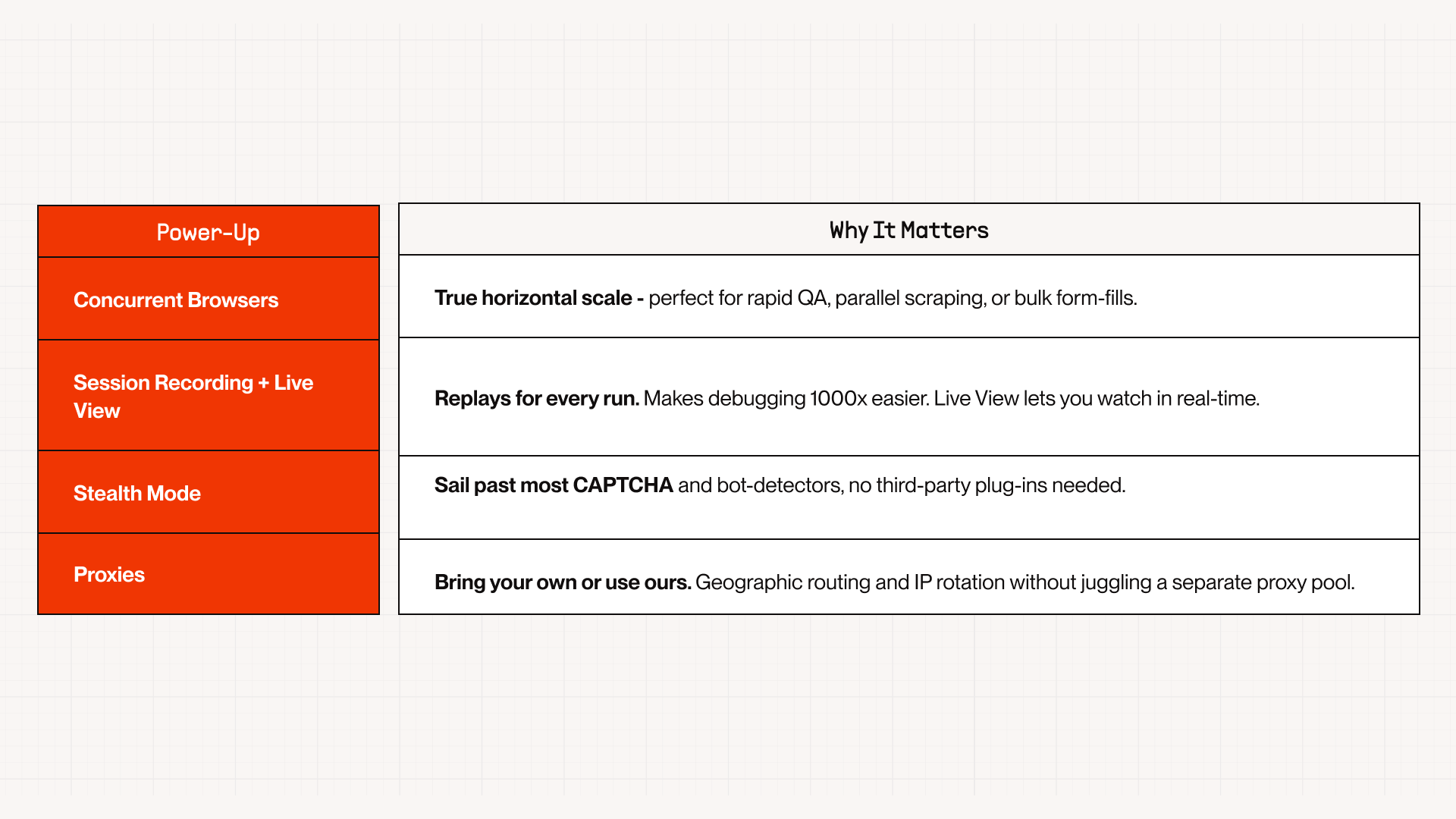
What can I use Browserbase for?
Copy linkBut first, what is Browserbase?
Simply put, Browserbase lets you run code-controlled or AI-controlled web browsers in the cloud.
It’s a browser infrastructure platform, which means we run your fleet of browsers so that you don’t have to deal with all that infra or compute. Whether it’s AI agents or traditional automations, we also make monitoring your fleet easy. It has several superpowers built-in to handle all the thorns that teams usually face when automating the open web:

In short, Browserbase shines when you need repeatable tasks at scale, hundreds or thousands of sessions your system can’t handle.
To make it easy to build AI Web Agents, we also built Stagehand. You can think of it as an evolution of the traditional automation frameworks (Playwright, Puppeteer, Selenium). Developers use Stagehand’s agent(), act(), extract(), and observe() primitives to imbue their scripts with LLM intelligence.
Copy linkWhat are people building with Browserbase + Stagehand?
Our customers and users have been building TONS of amazing things with Browserbase and Stagehand. We noticed 3 common themes…
1. Build an AI agent that surfs the web
- 1.1 Turn webpages into structured datasets (Structify)
- 1.2 Automatically sniff out new competitors
- 1.3 Faster merchant onboarding for food-stamp promotions (Benny)
- 1.4 Find a dinner spot equidistant from your friends
- 1.5 Get real-time background research on sales leads (Aomni)
- 1.6 Serve consumer agents with human-in-the-loop redundancy Convergence)
2. Automate a tedious process or workflow
- 2.1 Reach out to waitlisted users with personalized copy
- 2.2 Never forget to submit expense reports
- 2.3 Handle tedious sales-tax compliance with agents (Numeral)
- 2.4 Run due diligence on financial compliance for prospects (Parcha)
- 2.5 Build agents in HIPAA-sensitive domains (Commure)
- 2.6 Automatically verify HR compliance in hospitals
- 2.7 Automatically process incoming RFPs
3. Web scraping
- 3.1 Unearth data insights while avoiding rate limits and CDN defenses (Vercel)
- 3.2 Gauge investment quality of new real-estate listings
- 3.3 Eliminate browser instance scaling issues from spiky demand (PromptLoop)
- 3.4 Gather specific data to train a specialized model (Coframe)
- 3.5 Extract product reviews at scale
- 3.6 Automatically gather evidence for disability law firms (Chronicle Legal)
Copy link1. Build an AI agent that surfs the web
Need your agent to click, fill, or fetch like a human? Browserbase provides the disposable, stealth-ready browsers; Stagehand injects just enough AI to keep the flow alive when pages change. Together they turn “open a tab and do X” into a single API call, so teams can bolt real web interaction onto any model without babysitting a browser farm.
Turn webpages into structured datasets (Structify). Structify equips enterprises with AI crawlers that turn raw webpages into neatly structured data. Every crawl request triggers concurrent Browserbase sessions routed through rotating residential IPs; Stagehand extracts tables, prices, or SKU details that are then written to a central store. After moving off a self-hosted grid, Structify cut server RAM from gigabytes to almost zero and routinely scrapes tens of thousands of sites per run without worrying about fingerprinting or Kubernetes scaling.
Automatically sniff out new competitors. A small SaaS founder schedules a Stagehand job at 07:00. The agent opens Product Hunt, Hacker News, and Crunchbase through Browserbase’s stealth browsers. On Product Hunt and Hacker News, it analyzes new startups for any overlap in mission or customers. On crunchbase, it looks through funding events posted in the last 24 hours. Results are compiled into a Markdown summary and sent to Slack with a link to the session replay for any item that needs double-checking. One script, no self-hosted browsers, and the founder can keep an eye on the competitive landscape without hours of research.
Faster Merchant On-Boarding for Food-Stamp Promotions (Benny). Benny lets SNAP shoppers link their Walmart, Kroger, and H-E-B loyalty accounts so the app can pull purchase history and surface brand promotions. Because none of those merchants expose APIs, Benny originally ran hand-rolled Playwright scripts on AWS Lambda, hundreds of fragile flows that broke whenever a login screen or DOM was tweaked. Engineers were losing 4–5 hours a week per script just on upkeep, and adding a new merchant took up to two weeks. Moving the same logic to Stagehand agents running on Browserbase flipped the math: AI now adapts to layout changes, Browserbase replays cut issue-diagnosis time from 30 minutes to under a minute, and a new retailer can be onboarded in about one day. The shift also avoided a planned hire for a full-time “browser-infra specialist,” letting the team stay focused on financial-services features instead of scraping mechanics.
Find a dinner spot equidistant from your friends. A Stagehand agent takes in each friend’s current location, and queries Google Maps to find restaurants whose travel times differ by no more than ten minutes. It books the reservation via OpenTable and emails the details. Everyone is happy that they skipped the tedious process of searching through 15 restaurants to placate everyone. Live View lets a human step in if two-factor auth appears.
Get real-time background research on sales leads (Aomni). When an account executive enters a lead into Aomni, the backend kicks off a mini “crawl job” that fans out across the web: home-page, careers, press releases, LinkedIn, funding news, product docs, competitors. Instead of juggling a proxy service or a home-grown Playwright farm, Aomni launches a batch of parallel Browserbase sessions—one API call supplies both the reverse-proxy layer and the headless browser. Those sessions return fully rendered pages in a few seconds, the AI stack extracts ~1k data points, and the user sees a ready-made brief and personalised email draft before the call starts. By folding proxy and browser into a single service, Aomni delivers live, low-latency research at the moment of need and keeps its four-person team focused on AI logic rather than infrastructure plumbing.
Serve consumer agents with human-in-the-loop redundancy (Convergence). Convergence ran a consumer assistant app to handle a wide range of tasks—everything from booking a gym class to checking flight prices. Each task starts as a Stagehand script inside Browserbase; if the agent hits MFA or an unexpected prompt, the user receives a Live View URL and can finish the flow in the same session (a key feature that caused them to switch to Browserbase). Using Browserbase eliminated the need to build a custom pool of Playwright workers and, according to their team, saved them from having to dedicate 3-4 engineers just for browser infra.
Copy link2. Automate a tedious process or workflow
Many business tasks still hide behind dated web portals and multistep forms. By dropping those flows into Stagehand scripts that run on Browserbase, companies replace brittle scripts and nightly chores with hands-off jobs that scale, self-heal, and leave a replay trail for auditors—all while the core product team keeps its focus elsewhere.
Reach out to waitlisted users with personalized copy. When someone joins your product’s early-access list, a Stagehand agent fires up immediately. It opens the prospect’s website and LinkedIn page through Browserbase, identifies industry, funding stage, and recent headlines, then writes a note—“Saw your Series A last month; here’s why we’re a fit”—directly into HubSpot. The entire flow lives in one script, runs in under 60 seconds, and scales to any spike because Browserbase spins up new stealth browsers on demand.
Run due-diligence on financial compliance for prospects (Parcha). Parcha’s four-person engineering team helps banks onboard customers by collecting website content, corporate filings, and sanction lists—tasks that once kept analysts busy for an hour per business. With Browserbase’s pooled browsers they open all required sites in parallel, while Stagehand extracts and scores risk signals. The same workflow now runs in about 10 seconds, freeing the small team to focus on AI logic rather than a self-hosted Playwright grid and pushing compliance bottlenecks out of the onboarding flow.
Build agents in HIPAA-sensitive domains (Commure). Hospitals use Commure’s “Scout” product to watch payer portals for updates, grab PDFs, and reconcile claims. The R&D team needed live URLs for real-time QA, session recordings for audits, and reliable PDF downloads, requirements no other tool met in one package. Moving to Browserbase gave them HIPAA-compliant, managed browsers with those three features out-of-the-box; engineers stopped firefighting an in-house grid and focused on product work. Result: a 20x jump in daily claims processed, 8,000+ manual hours saved in three months, and confidence that PHI stays secure while bots navigate insurer sites
Never forget to submit expense reports. Every Friday a Stagehand workflow logs into the finance portal, uploads receipt PDFs from a tagged Gmail label, fills the expense form, and submits for approval. Browserbase session recordings give finance a replay if a claim is questioned, and residential proxies prevent rate-limit issues on shared corporate networks.
Handle tedious sales-tax compliance with agents. E-commerce sellers must log into 50-plus state portals, pass 2FA, file returns, and keep credentials fresh—each site with its own quirks. Numeral swapped days of hand-written Playwright per portal for Stagehand prompts that tell an agent “log in and file this month’s return,” letting Browserbase handle fingerprints, downloads, and residential proxies. Engineers now write far less code, AI adapts when a state shifts its DOM, and the team has begun rolling out automation nationwide, eliminating days of manual scripting for every new portal and keeping compliance work to “five minutes a month” for customers.
Automatically verify HR compliance in hospitals. Hospitals must prove every temp-nurse and travel nurse on shift holds an active licence in the state where they practice. A nightly Stagehand workflow starts at 2 am, spins up 50 parallel Browserbase sessions (one per nursing-board portal), and signs in with stored credentials. Many boards sit behind CAPTCHA or geo-checks, so the script runs with Advanced Stealth enabled and Browserbase’s residential proxies. Inside each site the agent locates the “License Lookup” table, enters the nurse’s number, and scrapes status and expiration dates. If a board quietly reorders columns or swaps IDs, Stagehand’s fallback LLM reroutes the selector, logs the change, and continues—no human patch cycle required. The script writes results to the hospital’s HR Information System, attaches the Browserbase replay URL for audit, and emails compliance if any licence is within 30 days of expiry, all before staff clock in.
Automatically process incoming RFPs. A Stagehand agent watches the “RFP” Gmail label; each time a vendor email lands, it downloads attachments, converts PDFs to text, and appends them to a single Notion page. Procurement gets a consolidated doc by morning, with Browserbase replays available for any attachment that fails OCR.
Copy link3. Web Scraping
A lot of times, users need to gather very specific, not easily accessible data. Whether you’re tracking prices across thousands of domains or building a market-intelligence engine, Browserbase supplies headless browsing at cloud scale, complete with rotating residential proxies and advanced anti-bot masking. Render the full DOM, capture screenshots, and fan out to millions of pages—no infrastructure or rate-limit surprises.
Unearth data insights while avoiding rate limits and CDN defenses (Vercel). Vercel built an internal system called Prism to crawl millions of domains—every site hosted on Vercel, top CrUX performers, funded startups, and large e-commerce stores—and turn that data into sales signals. Prism needs headers, full DOM, and the browser window object, which rules out lightweight HTTP scrapers. Browserbase supplies thousands of parallel Chrome sessions plus Advanced Stealth to bypass CDN defenses, letting Vercel refresh its corpus fast enough to power daily Slack alerts: churn-risk flags when a customer tests a rival platform, a “ship-velocity index” that tracks how often companies deploy code, and propensity models that feed the sales pipeline. What was once an unreliable Puppeteer farm is now a revenue engine that crawls the modern web at scale without internal browser-grid maintenance.
Gauge investment quality of new real-estate listings. An investment fund schedules a Stagehand job to crawl regional MLS sites at 2am. The agent logs in, applies specific filters (ZIP codes, price bands), scrolls through all pages to trigger lazy-loaded cards, and captures address, square footage, and listing agent into a database. Browserbase’s replay links are stored alongside each record so analysts can verify edge cases in a click, and rotating proxies keep the bot beneath MLS traffic thresholds.
Eliminate browser instance scaling issues from spiky demand (PromptLoop). PromptLoop lets go-to-market teams label tens of thousands of company websites in a single job—industry, tech stack, hiring signals—without writing code. The bottleneck was reliable JavaScript rendering under spiky demand: a customer may launch a 100,000-domain analysis that needs answers in hours. Swapping a self-hosted browser tier for Browserbase gave PromptLoop a stable, on-demand layer that spins up thousands of stealth browsers and rotates residential IPs automatically. Success rates for accessible sites climbed from ~87% to over 95%, engineers recovered the DevOps hours once spent debugging ECS scaling failures, and the team now processes an order-of-magnitude more jobs each month while focusing on model quality, not browser plumbing.
Gather specific data to train a specialized model (Coframe). Coframe builds an AI system that automatically proposes and A/B-tests new versions of a customer’s hero section, banner, or checkout flow. To train its model, Coframe first needs a big library of live site snippets. With Browserbase, it spins up hundreds of parallel, stealth browsers, loads each target URL, extracts the HTML + CSS that render the section, and feeds the code to its “AI copywriter + designer” pipeline. Jobs that once waited in a slow Playwright queue now finish in minutes, and Coframe’s engineers never touch proxy or CAPTCHA logic—they stay focused on the experimentation engine.
Extract product reviews at scale. A consumer-analytics startup uses Stagehand prompts to paginate marketplace listings, open each product page, and scrape ratings, price history, and verbatim reviews. Set Browserbase to rotate residential IPs every couple dozen pages. Results stream into a sentiment model; management dashboards refresh hourly without triggering marketplace rate limits.
Automatically gather evidence for disability law firms (Chronicle Legal). Disability attorneys must check the federal ERE portal for new evidence on hundreds—or in large firms, thousands—of active Social-Security cases. Chronicle’s founder first tried a self-hosted Selenium grid but spent hours each week nursing hung containers and scaling capacity. Migrating to Browserbase replaced that brittle setup with managed stealth browsers that spin up on demand and stay compliant with government-site security. Today Chronicle runs 100k+ sessions per month with virtually no downtime, provides replay links so paralegals can verify each scrape, and touts browser reliability as a competitive edge—all without adding DevOps headcount.
Copy linkWe Didn’t See This Coming 🤯
There are many use cases that we predicted when building Browserbase, but our customers manage to keep surprising us with their creativity:
-
Internal “busy-work” automations – Enterprise tooling like Workday are so clunky they take hours of productivity away from an employee every week. With Browserbase, we’ve seen customers automate these wasteful internal tasks away.
-
QA & UX Testing – Teams spin up an AI agent in Stagehand, tell it “find the contact page,” and watch how many steps it takes. If the bot struggles, that’s an indication that real users would struggle too. Because every session is recorded, product managers can replay the journey and fix navigation dead-ends before real users complain.
-
Synthetic user traffic for analytics demos – An analytics provider wanted to show their customers predictive usage data. By launching swarms of headless browsers that wander sites like real visitors, they populate engagement graphs without relying on staged data.
The pattern: once a session-recorded, intelligent browser is just an API call away, teams apply it to chores we never imagined when we first built Browserbase.
Copy linkLooking Down the Road
We can only speculate but we think in the next 3 years:
-
Consumer use cases explode – Booking DMV renewals, snagging sneaker drops, disputing credit-card fees. Personal web agents will become as commonplace as password managers.
-
Hybrid systems win (AI + deterministic scripts) – Pure agentic solutions will continue to be less performant than a hybrid between a deterministic script and intelligent AI decisioning. Stagehand’s act() with caching falls back to the LLM only when the DOM changes, otherwise it uses the proven selectors. We think this concept will continue to prove most effective.
-
Invisible background agents – Finance ops, partner integrations, even SaaS-to-SaaS interactions will quietly rely on headless browsers to bridge the “no-API” gap. End-users may never know an agent clicked the button for them, but they’ll notice faster outcomes and fewer manual steps.
Copy linkSo What Will You Build?
Browserbase provides ready-to-use, cloud browsers with stealth, proxies, concurrent sessions, and session recording built in. Run plain Playwright scripts or add LLM intelligence with Stagehand, and scale from one browser to hundreds without running your own grid. Whether you’re building internal automation, a new consumer AI product, automate data entry, or pretty much anything you can think to do on a browser, check out Browserbase and Stagehand.
Teams at Vercel, Perplexity, Commure and more are already shipping products on top of Browserbase!
Play around in our playground or book a demo.
Let’s build together. On your mark… get set… GO!! 💥


